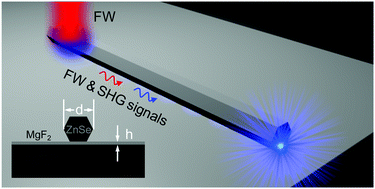当前位置:
X-MOL 学术
›
Mater. Chem. Front.
›
论文详情
Our official English website, www.x-mol.net, welcomes your
feedback! (Note: you will need to create a separate account there.)
Loss compensation during subwavelength propagation of enhanced second-harmonic generation signals in a hybrid plasmonic waveguide†
Materials Chemistry Frontiers ( IF 6.0 ) Pub Date : 2018-01-02 00:00:00 , DOI: 10.1039/c7qm00471k Xianqing Lin 1, 2, 3, 4, 5 , Jian Ye 1, 2, 3 , Yongli Yan 1, 2, 3, 4, 5 , Haiyun Dong 1, 2, 3, 4, 5 , Jianmin Gu 1, 2, 3 , Wei Zhang 1, 2, 3 , Cong Wei 1, 2, 3 , Jiannian Yao 1, 2, 3, 4, 5 , Yong Sheng Zhao 1, 2, 3, 4, 5
Materials Chemistry Frontiers ( IF 6.0 ) Pub Date : 2018-01-02 00:00:00 , DOI: 10.1039/c7qm00471k Xianqing Lin 1, 2, 3, 4, 5 , Jian Ye 1, 2, 3 , Yongli Yan 1, 2, 3, 4, 5 , Haiyun Dong 1, 2, 3, 4, 5 , Jianmin Gu 1, 2, 3 , Wei Zhang 1, 2, 3 , Cong Wei 1, 2, 3 , Jiannian Yao 1, 2, 3, 4, 5 , Yong Sheng Zhao 1, 2, 3, 4, 5
Affiliation

|
Ultracompact coherent light sources with broadband wavelength tunability and subwavelength optical waveguiding have attracted extensive attention due to their potential applications ranging from multicolor detection to multiband on-chip photonic communication. Metal–dielectric nonlinear structures, which comprise nonlinear dielectric materials and metal films, have been widely used to generate nanoscale broadband tunable coherent light sources through the second-harmonic generation process below the diffraction limit. However, restricted by high ohmic losses at the metal–dielectric surface, subwavelength propagation of SHG signals with low loss remains a big challenge. Here, a novel strategy is utilized to reduce the propagation loss of SHG signals based on the coupling between the waveguide mode and plasmonic mode in a hybrid plasmonic waveguide (HPW). The generated hybrid plasmonic mode in the HPW exhibits strong optical confinement around the nonlinear dielectric and insulating gap, which is beneficial for minimizing the ohmic losses at the metal–dielectric interface and enhancing the light–matter interaction below the diffraction limit. Moreover, under the phase matching condition, the propagation loss of SHG signals is partially compensated for by the frequency conversion of the fundamental wave (FW) through the SHG process. As a result, low propagation loss of enhanced SHG signals at a subwavelength scale is realized in HPWs.
中文翻译:

混合等离子体激元波导中增强次谐波产生信号在亚波长传播期间的损耗补偿†
具有宽带波长可调性和亚波长光波导的超紧凑相干光源由于其潜在的应用范围从多色检测到多波段片上光子通信而引起了广泛的关注。金属-电介质非线性结构,包括非线性电介质材料和金属膜,已被广泛用于通过低于衍射极限的二次谐波产生过程来产生纳米级宽带可调谐相干光源。然而,受金属-介电表面高欧姆损耗的限制,低损耗SHG信号的亚波长传播仍然是一个很大的挑战。这里,基于混合等离子体波导管(HPW)中波导模式与等离子体模式之间的耦合,采用了一种新颖的策略来减少SHG信号的传播损耗。HPW中产生的混合等离子体激元模式在非线性介电和绝缘间隙周围表现出强烈的光学限制,这有利于最大程度地减小金属-电介质界面处的欧姆损耗,并增强在衍射极限以下的光-物质相互作用。而且,在相位匹配条件下,SHG信号的传播损耗通过通过SHG过程的基波(FW)的频率转换而得到部分补偿。结果,在HPW中实现了增强的SHG信号在亚波长范围内的低传播损耗。HPW中产生的混合等离子体激元模式在非线性介电和绝缘间隙周围表现出强烈的光学限制,这有利于最大程度地减小金属-电介质界面处的欧姆损耗,并增强在衍射极限以下的光-物质相互作用。而且,在相位匹配条件下,SHG信号的传播损耗通过通过SHG过程的基波(FW)的频率转换而得到部分补偿。结果,在HPW中实现了增强的SHG信号在亚波长范围内的低传播损耗。HPW中产生的混合等离子体激元模式在非线性介电和绝缘间隙周围表现出强烈的光学限制,这有利于最大程度地减小金属-电介质界面处的欧姆损耗,并增强在衍射极限以下的光-物质相互作用。而且,在相位匹配条件下,SHG信号的传播损耗通过通过SHG过程的基波(FW)的频率转换而得到部分补偿。结果,在HPW中实现了增强的SHG信号在亚波长范围内的低传播损耗。SHG信号的传播损耗通过SHG过程通过基波(FW)的频率转换得到了部分补偿。结果,在HPW中实现了增强的SHG信号在亚波长范围内的低传播损耗。SHG信号的传播损耗通过SHG过程通过基波(FW)的频率转换得到了部分补偿。结果,在HPW中实现了增强的SHG信号在亚波长范围内的低传播损耗。
更新日期:2018-01-02
中文翻译:

混合等离子体激元波导中增强次谐波产生信号在亚波长传播期间的损耗补偿†
具有宽带波长可调性和亚波长光波导的超紧凑相干光源由于其潜在的应用范围从多色检测到多波段片上光子通信而引起了广泛的关注。金属-电介质非线性结构,包括非线性电介质材料和金属膜,已被广泛用于通过低于衍射极限的二次谐波产生过程来产生纳米级宽带可调谐相干光源。然而,受金属-介电表面高欧姆损耗的限制,低损耗SHG信号的亚波长传播仍然是一个很大的挑战。这里,基于混合等离子体波导管(HPW)中波导模式与等离子体模式之间的耦合,采用了一种新颖的策略来减少SHG信号的传播损耗。HPW中产生的混合等离子体激元模式在非线性介电和绝缘间隙周围表现出强烈的光学限制,这有利于最大程度地减小金属-电介质界面处的欧姆损耗,并增强在衍射极限以下的光-物质相互作用。而且,在相位匹配条件下,SHG信号的传播损耗通过通过SHG过程的基波(FW)的频率转换而得到部分补偿。结果,在HPW中实现了增强的SHG信号在亚波长范围内的低传播损耗。HPW中产生的混合等离子体激元模式在非线性介电和绝缘间隙周围表现出强烈的光学限制,这有利于最大程度地减小金属-电介质界面处的欧姆损耗,并增强在衍射极限以下的光-物质相互作用。而且,在相位匹配条件下,SHG信号的传播损耗通过通过SHG过程的基波(FW)的频率转换而得到部分补偿。结果,在HPW中实现了增强的SHG信号在亚波长范围内的低传播损耗。HPW中产生的混合等离子体激元模式在非线性介电和绝缘间隙周围表现出强烈的光学限制,这有利于最大程度地减小金属-电介质界面处的欧姆损耗,并增强在衍射极限以下的光-物质相互作用。而且,在相位匹配条件下,SHG信号的传播损耗通过通过SHG过程的基波(FW)的频率转换而得到部分补偿。结果,在HPW中实现了增强的SHG信号在亚波长范围内的低传播损耗。SHG信号的传播损耗通过SHG过程通过基波(FW)的频率转换得到了部分补偿。结果,在HPW中实现了增强的SHG信号在亚波长范围内的低传播损耗。SHG信号的传播损耗通过SHG过程通过基波(FW)的频率转换得到了部分补偿。结果,在HPW中实现了增强的SHG信号在亚波长范围内的低传播损耗。











































 京公网安备 11010802027423号
京公网安备 11010802027423号